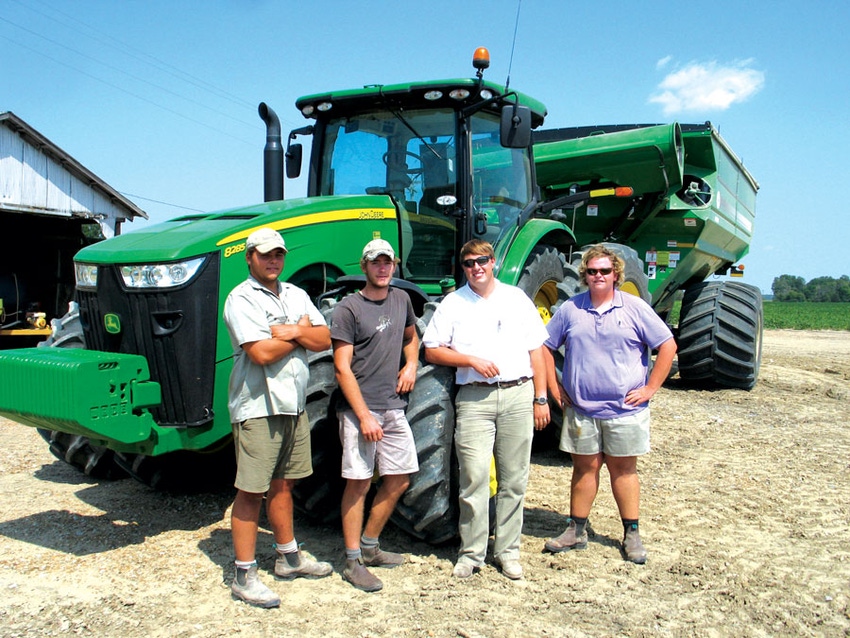November 20, 2012

This is my very first crop,” says Adron Belk III in early September as he makes one final pass over the last few rows of Roundup Ready corn on Triple Run Farms, located in the Mississippi Delta just outside of Cleveland. He’s ending a 120-hour work week, trying to beat the threat of Hurricane Isaac.
The 23-year old producer graduated in May 2011 from the University of Mississippi and returned to the land where his father, Ricky Belk II, has farmed for over 20 years. The Belks, however, made an important decision when the younger Belk decided to farm for a living.
“If Adron was going to farm, we decided his operation would be entirely separate from mine,” says Ricky. Although the decision meant greater risk on the front end, Adron agreed.
“All I’ve ever wanted to do was be on the farm,” he says. “In my world, the three things most important are the Lord, family and work.”
During his first year, drought made his job particularly challenging on the 2,600 acres of farmland where he grew 1,100 acres of corn, 1,200 of soybeans, and 300 of rice.
Having spent his entire youth working alongside his father, he made a key decision when it came to his education. “I decided to study real estate and finance because I already knew how to farm. I needed to understand the business side of farming. This first year, I’ve used my finance minor more than anything else.”
“Chasing the market” can be a challenge, Adron says, particularly when making his own decisions about crops, fertility programs, equipment and more. And while he relies heavily on his seed and crop consultants, and occasionally his father, his uncannily calm maturity led him to rely on his own judgment more than once in 2012.
While his dad’s crew is all local, Adron decided to go a different route, working with South Africans who look specifically for work with U.S. farming operations. “They’re great — I have three with me this year,” he says
Starting with seed varieties, Belk chose a mixture of new and proven Roundup Ready varieties.
“I chose Asgrow AG4732 brand because it’s supposed to be good on heavier land, and Pioneer 93Y92 because it’s a good dryland bean. This was my first year to try AgVenture, and I planted 48K8, 50K5, and 51X5 because they’re all-around good irrigated beans.”
With soil that is pure gumbo, or mixed but still heavy, he chose to plant on 30-inch rows, using a track tractor rather than rubber tires. Soybean planting proved especially difficult, with conditions swinging from one extreme to another. “Our biggest headache was that it was so dry when we tried to plant,” he says.
When it rained a scant one inch, Adron and his crew seized the window and planted. Because the ground was so dry, they spent time laying polypipe. “The dry soil was the biggest headache — we put down polypipe, watered, planted and then laid more pipe.”
Ironically, wet weather followed.
“We started planting during the first week of May and got all 1,200 acres of beans planted in five days. Then, it rained five inches, and we had to replant about 35 percent of the crop. And after replanting, it rained another four inches.
“Although the plants were at different stages, we just had to go with what we had because it was so late,” says Adron. He planted 650 acres on irrigated land and the remaining 550 on dryland. “We only watered the late beans two times this season,” he says.
Triple Run utilizes little no-till, but Adron says, “Our dryland beans were no-till because the land was in good shape, and it cost less,” says Belk.
He sprayed twice for stink bugs and worms, using Belt, Intrepid or Brigade, but says the crop was remarkably free of insect problems.
Palmer amaranth or pigweed continues to be a major problem for Delta growers. “We do the best job we can to control it,” he says. “It cannot be addressed enough.”
As of September, Adron had only harvested 120 acres of his early beans, with Pioneer 93Y92, yielding approximately 35 bushels per acre. “The problem with this crop is that it has either been really dry or really wet. It remains to be seen how we’ll come out.”
For corn, he chose to plant DEKALB 6697, 6469 and Terral 28HR20 with a 35,000 per acre plant population, and AgVenture 9795 and 9694 at 32,000. He irrigated all the corn, watering once weekly. At harvest, moisture hovered around 17 percent in his last field. Yields ran 200 bushels per acre.
“All the corn did great,” Adron says. “We had no pest or disease problems.”
He and his father buy new tractors every year and purchase other equipment. “We have very little downtime — the main reason we buy new equipment,” he says.
Sitting in his new Claas combine at the end of his corn harvest, Adron reflects on his first year of farming.
“It’s hard to explain farming to non-farmers. Believe me, I’m making enough mistakes on my own, and some days, I think, ‘What am I doing out here?’”
Newly married, he’s grateful for the strong support of his wife. “She gets it — she understands the long hours,” he says.
Looking to 2013, Adron plans on applying Roundup this fall in anticipation of going straight into planting next spring. “We burned a lot of fuel on heavy ground prep,” he says.
He also plans to market his crop differently — not selling as early as he did in 2012. Keeping up with technology and varieties is challenging. “There are so many varieties of corn and beans. I go to meetings to keep up with the technology, which can be obsolete tomorrow.”
Climbing off the combine, he gathers his crew and heads off for more work, both today and hopefully far into the future.
You May Also Like




